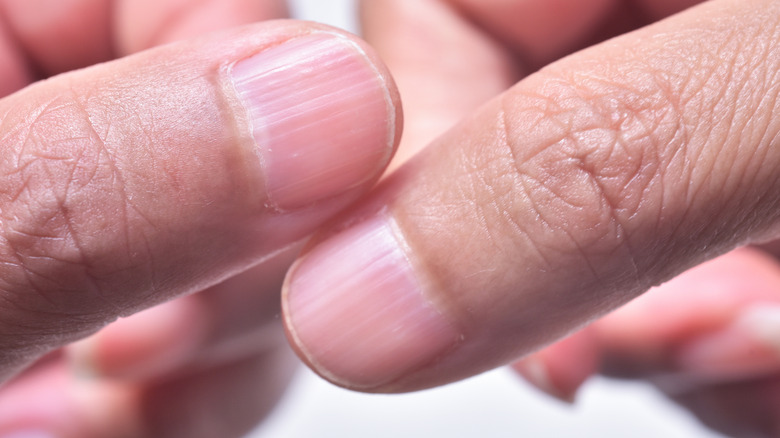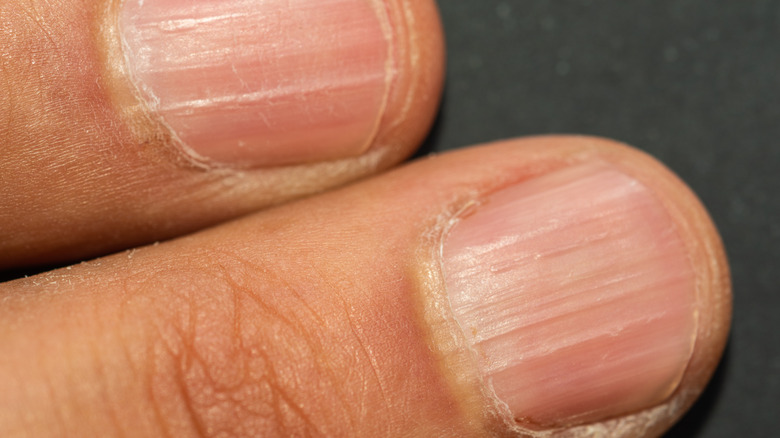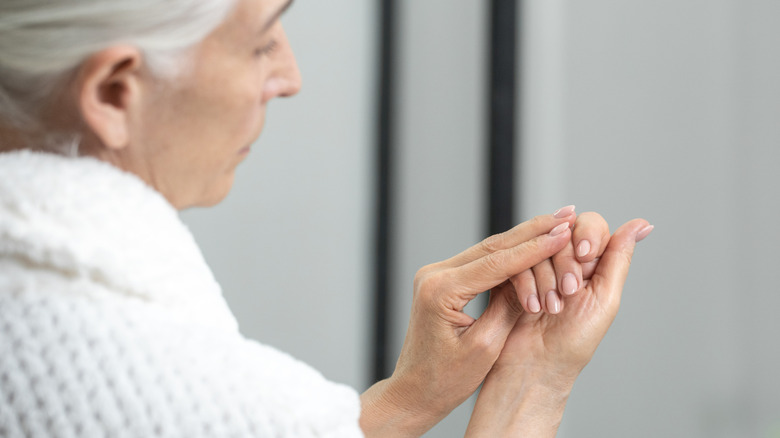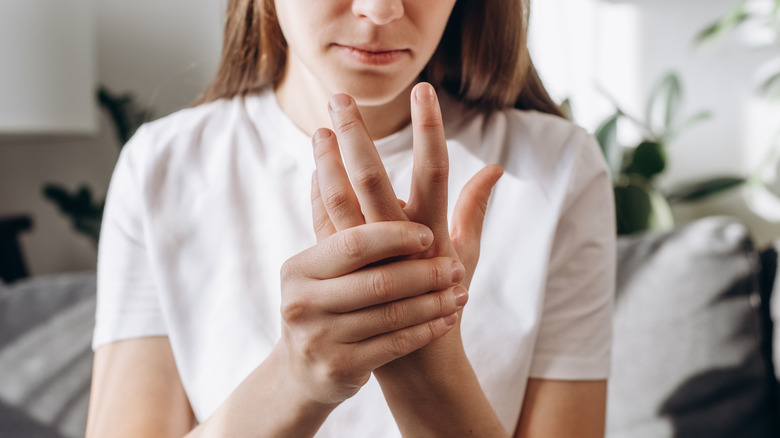What Does It Mean When You Have Ridges On Your Fingernails?
You might not think about your fingernails very much beyond cutting them every once in a while. Or maybe you paint them or get them done at the salon, seeing them as a way to express yourself and your sense of style. But it turns out that our fingernails may actually be an indicator of our overall health if we pay attention.
Nail health can often reveal other problems going on inside our bodies, according to Healthline. Most often, it can point to poor nutritional intake or poor digestion. But sometimes it can indicate more serious conditions, like kidney disease.
When the body is meeting other, more pressing demands elsewhere it directs energy away from growing nails, which is a lower priority than, say, fighting an infection (via Mayo Clinic). This can sometimes cause abnormalities in the nails, indicating that something bigger is going on, until they resume growing again.
What the direction of your nail ridges can mean
It's common to have vertical ridges on the nails, which run from the bottom to the tip, notes The Healthy. In fact, 20% of adults will develop vertical ridges, which are usually just a sign of aging. Hair, skin, and nails contain the same protein, keratin. And, just as the hair and skin get drier as we age, so do our nails. This can often lead to vertical ridges as our nails struggle to retain moisture.
It's less common to experience horizontal ridges on the nails, or ridges that run side to side. These are known as Beau's lines. Often, they can be due to injury to the nail bed that stops the nail from growing, like jamming your finger in the door or getting injured during a manicure. But sometimes these horizontal lines can be due to something more serious, like acute kidney disease. If Beau's lines show up on all 20 fingernails and toenails, it could be a symptom of parathyroid disease, mumps, unmanaged diabetes, syphilis, respiratory conditions, illnesses with prolonged fevers, or zinc deficiency. They can also be a side effect of chemotherapy, says Healthline. If you're unsure whether to be concerned about ridges in your nails, see a dermatologist.
Trauma to the nail
A traumatic injury can do significant damage to your nail, causing it to "bruise" and disrupting its natural growth in addition to impacting its appearance. Visible ridges can form as a result, usually in the form of Beau's lines — or even small bumps that remain there even after the initial injury heals. Trauma can vary from slamming your finger in a door to stress due to repetitive activity, like frequent tapping.
The matrix, which is the area beneath the cuticle that's responsible for building new nail cells, can become damaged and affect growth. That's what leads to the telltale ridges, which in turn is what prevents your nails from continuing to grow. Depending on the severity of the trauma, it may take several months for the nail to grow out. In more severe cases, the trauma could affect the matrix permanently. That could lead to more lasting irregularities in nail texture or thickness.
It's worth noting that trauma isn't always the result of a major event or accident. Even something as simple as wearing ill-fitting footwear or chronically picking at your nails could be enough to cause subtle yet lasting damage. The good news is that time and patience usually see your nail undergo an improvement. Trimming nails and protecting them from further injury can encourage healthier growth.
Nail growth problems cause onychorrhexis
Onychorrhexis is a nail disorder that causes vertical ridges to form. They typically lend the nails a "striped" appearance as they run the length. Because the nails may grow more brittle with onychorrhexis, it can ultimately cause them to soften, split, and break. While the condition is not dangerous, it can be a sign of other health issues. For example, some people with rheumatoid arthritis, thyroid disorders, and heart disease may be more prone to developing onychorrhexis.
Sometimes, though, the culprit is simply aging. People's nails can lose their integrity as they grow older, leaving them dull and less resilient than they were earlier in life. Interestingly, the condition doesn't necessarily affect all of your nails — in some cases, it may even be limited to just one. It's not always easy to determine the cause, which is why it's important to see a medical provider — especially if the symptom is new or appears to be growing more significant. Your doctor can determine whether it's a symptom of another health issue.
Your treatment will depend on the underlying cause. If it's related to a nutrient deficiency, you may simply need to add a supplement to your routine. If it's related to age, adding a few nail care steps to your self-care regimen can be helpful. Moisturizing, avoiding biting, and drinking enough water while consuming healthy foods can help support nail health and potentially prevent onychorrhexis from worsening.
Psoriasis of the nail
Psoriasis is an autoimmune condition that can cause inflammation to run rampant in the body. Because skin cell production is essentially in overdrive, raised patches can develop. They may be red, scaly, and feel itchy — and be very difficult to control. There are different types of psoriasis, though, and in some cases people may experience symptoms that affect their nails. When this develops, the nails may appear irregular, with small "dents" or ridges that almost resemble small pits in the nails. They can also develop Beau's lines as the condition progresses.
All of these changes can impact the structural integrity of your nails, leading to chronic discomfort in some cases. Unfortunately, there is no cure for psoriasis, but there are treatments that may help. Your dermatologist may prescribe corticosteroids or a vitamin A derivative to reduce symptoms. In some cases, injectable biologic psoriasis medications — which are formulated to block the immune system from developing skin cells too fast — may be prescribed. This can have a widespread treatment effect.
From an aesthetic perspective, symptoms of psoriasis can be difficult to hide. If you're conscious of the appearance of your nails, it's usually safe to apply nail polish to conceal the imperfections. Just avoid using fake nails, as everything from the glue used to affix them to the application (and removal) method can aggravate the nail, leading to worse damage.
Underactive thyroid affects nail keratin
An underactive thyroid can affect the body in different ways, even causing structural changes to the nails. Hypothyroidism develops when the thyroid gland does not make enough of the hormones responsible for cell growth. Dermatologist Dr. Hannah Kopelman, M.D. explains to Yahoo! Life, "The thyroid gland produces hormones that are crucial for regulating our metabolism, which affects how quickly cells grow and repair. When the thyroid isn't working properly, it disrupts this balance, leading to issues with the nails."
Specifically, people with hypothyroidism may develop vasoconstriction, which causes the blood vessels to thin. Because blood volume to the nails is reduced, it can affect the condition of the nails. "This results in thick, slow-growing nails that are brittle with noticeable vertical ridges. It can also cause the nails to crumble and break easily or cause the fingertips to look puffy," says dermatologist Natalie Hone, M.D. (via Yahoo! Life).
If your doctor diagnoses you with hypothyroidism, you'll usually be prescribed medication to replace the hormone. That can help minimize many of the symptoms associated with the condition, potentially strengthening your nails in the process. Practicing good nail hygiene can be helpful, too. Keeping your nails short, for example, can prevent breakage and further weakening of their structure.
Rheumatoid arthritis can change the nails
Like psoriasis, rheumatoid arthritis is an autoimmune condition that causes inflammation to flare throughout the body. While that inflammation typically impacts the joints and makes movement difficult, it can also affect the nails. Experts aren't entirely sure of the precise cause, according to Dr. Kimberly Werner Billet, M.D. She tells HealthCentral, "The mechanism behind nail ridging in RA patients is still debatable." However, she added, the symptom could occur if the blood vessels in the nails are so inflamed that they cause ridges to form.
A study published in The Egyptian Rheumatologist found that 32.6% of patients with rheumatoid arthritis showed evidence of nail ridges when inspected with a magnifying glass (with 27% of patients' ridges visible with the naked eye). While the ridges are not serious, some people may find them aesthetically displeasing.
"There are no specific topical treatments for RA-related nail issues," explains dermatologist Dr. Karan Lal, D.O. (via HealthCentral). He recommends practicing focused nail care by keeping them short, ensuring they're clean, and limiting exposure to harmful agents. Dr. Billet adds that treatments should ideally focus on reducing inflammation, as the condition is systemic and the nail symptoms are an effect of that.
Insufficient protein intake
Protein is vital for so many reasons, not least because it can affect the condition and strength of your nails. In fact, ridges in the nails can be a sign that you aren't consuming enough of this important macronutrient. Nails are made with keratin, a type of protein. If your body lacks the sufficient building blocks required to make keratin, it can affect your nails in different ways. Growth can be affected, for example, and their structural integrity may weaken. That can lead to issues like peeling and ridges.
The reason is primarily due to prioritization in the body. When your protein intake isn't sufficient, your body needs to decide where to direct its energy. It will always put functions like supporting organs and repairing muscles over nail production, which accounts for the potential changes you might see. Those visual symptoms, though, can tip you off that something might be amiss, especially if the ridges become more pronounced over time.
While the changes to your nails are a significant sign, you may also notice changes to the look and feel of your hair and skin, both of which keratin supports. If you suspect you may have a nutritional deficiency, you can try increasing your protein intake to help your body make keratin more efficiently. Helpful foods to consider include eggs, salmon, broccoli, carrots, and sweet potatoes.
Chronic kidney disease may change the nails
People who have chronic kidney disease may notice that their nails subtly change as the disease progresses. There are different stages of kidney failure, and as it reaches the latter years, it becomes more difficult to manage. Along with symptoms like weakness and difficulty urinating, a visible sign can sometimes be the formation of ridges or discoloration of the nails. Usually they'll appear as horizontal lines, or a distinct separation between the pink and white parts of the nail. While not everyone with kidney issues will experience nail changes, it can be a clue that there is something deeper going on.
Specifically, these changes may develop because the kidneys don't work properly anymore, affecting their ability to process nutrients, toxins, and proteins efficiently. That can cause waste to accumulate in the bloodstream, making it harder for the body to absorb the vital nutrients that it requires to thrive — and to keep things like your nails healthy. Over time, that can weaken the nails, slow growth, and cause those telltale ridges to form.
Unfortunately, there aren't many direct treatments for nail changes related to kidney disease. The most important step is to address the underlying issue. For kidney patients, that means dietary management, in particular managing (and potentially eliminating altogether) intake of sodium, phosphorus, and protein. A nephrologist is critical to prescribing the right combination of medications to help patients manage the disease and enjoy an improved quality of life.
Effects of chemotherapy
Chemotherapy is a life-saving measure for millions of people. However, it can come with a host of side effects, including changes to the nails. The drugs used to treat cancer are formulated to target the cells, including those contained in the nail matrix. Those cells stimulate growth, and when they're killed off during chemotherapy, the nails may come in much more slowly or develop visible imperfections, such as horizontal ridges.
The American Cancer Society recommends that patients who experience ridges resulting from chemotherapy apply a protective nail polish. This might be a water-soluble formula that creates a barrier to prevent further damage, or it may be a prescription product, depending on the severity of the ridges. In some cases, the latter may be a more suitable choice if the nails are splitting and brittle on top of forming ridges.
For many, these side effects are temporary, and should resolve at some point following treatment. That said, it can be frustrating to deal with a dramatic change to the nails. Per the University of Texas MD Anderson Cancer Center, it's best not to get nail treatments (like manicures) during treatment. Instead, keep nails trimmed short, and moisturize using mild, fragrance-free lotion. Practicing gentle routines like these can also be a form of soothing self-care during a very trying time.
Stress may cause nail abnormalities
Dealing with stress can take its toll in so many ways. While it's something we associate primarily with mental health, it can also have a significant effect on the nails over time. Your nails require several key nutrients, vitamins, and minerals to stay resilient and maintain their structure. Because stress affects the body's ability to absorb many of those, including protein and iron, you may eventually experience a change to your nails.
If you're stressed, you may also develop habits like biting your nails or tapping them excessively. While they may seem relatively harmless, over time they can have an effect on the nails' structure. Dermatologist Dr. Karan Lal, D.O., tells Prevention that biting is actually traumatizing to the nail. Plus, adds dermatologist Dr. Noelani González, M.D., "By not picking at your nails or the skin around them, you're decreasing the chances of causing nail irregularities."
Although stress can be difficult to manage, there are several go-to methods for dealing that may help you cope — and reduce the strain on your nails, too. Practicing mindfulness, exercising, finding an outlet for your frustration, and limiting exposure to social media and news can all be helpful tactics that may ease your stress and help you avoid coping mechanisms like nail-biting.
When to see a doctor
It's important to keep in mind that ridges in the nails aren't always a sign of something serious. Vertical lines are typically indicative of normal aging, but the horizontal Beau's lines may suggest something else is going on. Dermatologist Dr. Soraya Azzawi, M.D., explains to USA Today that they're indicative of something underlying, like trauma to the nail or some type of illness.
Dermatologist Dr. Angela Kim, D.O., tells Good Housekeeping it's helpful to seek medical counsel if you're uncertain. "Board-certified dermatologists are experts of skin, hair and nails and are trained to gather and piece together the puzzle to narrow down a list of potential diagnoses and arrive at the most likely or correct diagnosis," she explains. Consider the severity of the ridges, too, and also whether they've grown worse over time or you're experiencing other potentially concerning symptoms, like changes to your nail color.
It's always better to be safe, and a doctor can conduct testing to determine the underlying cause and develop an appropriate treatment plan. According to Mayo Clinic dermatologist Dr. Rachel Miest, M.D., the nails can tell medical professionals a lot about your health. "The fingernails are absolutely a wonderful reflection of a person's overall health," she states.
When the doctor says everything is fine
It can be frustrating to visit the doctor's office with a specific concern, only to be told that there's nothing medically wrong. On the one hand, that can be an enormous relief. On the other hand, you're still dealing with mysterious ridges on your nails! Luckily, there are a few solutions you can try that may be helpful. Among them is one of the most simple: Give your nails the VIP treatment. Moisturize your cuticles, and don't bite them (chronic nail biting can be riskier than you realize).
A nail hardener may also help, especially if the issue is related to weakened or splitting nails. In this case, your dermatologist might recommend a nail-strengthening agent that creates a protective barrier and fills in the grooves in your nails. If you're shopping around for an over-the-counter formula, read the ingredients closely. "In-store hardeners typically contain formaldehyde, which can temporarily harden nails in the short-term, but ongoing use can actually cause the nails to become more brittle and weak," Dr. Amanda Zubek, M.D., Ph.D., tells Prevention.
Watch your diet, too. Even if your doctor determines there's no medical cause for the ridges, you can still help the situation by eating a vitamin- and mineral-rich diet filled with a rainbow of fruits and vegetables. Dr. Sara Obayan, M.D., M.P.H., a dermatologist in Austin, TX, tells Good Housekeeping, "Nail health starts from our insides."












